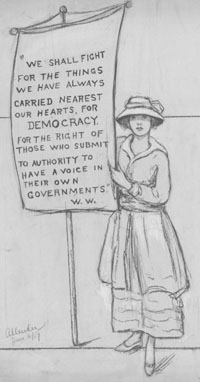Tea and rebellion are part of our American heritage. So it isn't surprising that one of the marketing strategies used by suffragists highlighted colonial history by selling tea themselves. This particularly clever campaign came out of California in 1911 when suffragists there tried to obtain the vote for themselves.
One of the ways that the women combined fund raising with propaganda was by selling tea. Two different groups in that state sold packages of tea.
"Equality tea" was sold in Northern California.
The packages were sold at grocers, by mail, and at fairs. I like the way the group chose this pretty woman to be advertised as one of the women selling tea:
The suffragists in northern California even opened a tea room at their party headquarters.
"Votes for Women Tea" was sold in Southern California. I couldn't find an image of the packages but I do know that Mrs. R. L. Craig, a well known grocer, was a driving force for suffrage and selling the tea. She was also the only woman in the local grocer association.
California suffragists were lucky. In October of 1911, California became the sixth state to grant women the right to vote.
This story may give you an idea for a quilt. I have made numerous tea cup quilts and I know there are free patterns for paper-pieced and appliqued patterns for tea cups.
Today we are also sponsoring a giveaway! Many of us experience what I call a "February Funk" this time of year. Would two packs of batik charm packs perk you up? Well we are sponsoring a giveaway that will end on Saturday night.
Just for fun, tell me what warm drink cheers you up this time of year! Leave a comment on this post or email me at allentownquilter@gmail.com
Have a wonderful day!







































